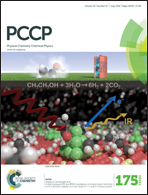Glass transition dynamics and cooperativity length of poly(ethylene 2,5-furandicarboxylate) compared to poly(ethylene terephthalate)
Abstract
The glass transition of poly(ethylene 2,5-furandicarboxylate) (PEF), an emergent bio-based polyester, was investigated in comparison to one of its chemical analogues: poly(ethylene terephthalate) (PET). These investigations were conducted at different crystallinities by means of stochastic modulated differential scanning calorimetry (stochastic TMDSC) and dynamic mechanical analysis (DMA). Amorphous PEF presents a higher ΔCp at the glass transition and a broader relaxation spectrum attributed to a higher free volume. The higher Tg of PEF is then purely related to segmental mobility and specific interactions in PEF. The length of cooperative rearranging regions (CRR) was similar for both materials. Additionally, the variations of the effective activation energy E of PEF and PET at glass transitions were determined by isoconversional kinetic analysis. The rate of decrease in E was similar for the two amorphous polyesters. Upon crystallization, the glass transition of PEF is broadened but its temperature range is not increased as with PET. The creation of the rigid amorphous fraction (RAF) with crystallinity is lower in PEF than in PET. The difference in free volume also explains the lower coupling between the crystalline phase and the amorphous phase in PEF.


 Please wait while we load your content...
Please wait while we load your content...